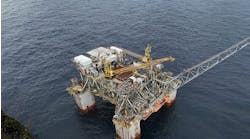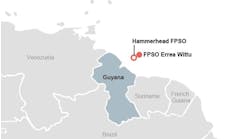Devils Tower is world's deepest spar
Jaime Kammerzell
Gulf of Mexico Editor
The Devils Tower field in 5,610 ft of water in Mississippi Canyon block 773 began production on May 5 as the world's deepest dry tree spar and the first deepwater facility Dominion E&P operates.
The field, 140 mi southeast of New Orleans, encompasses multiple reservoirs and fault blocks. Dominion chose the dry tree solution based on time and cost factors.
"We looked at the cost of re-completing wells or doing future work, and dry trees are more efficient than wet trees from a capital standpoint," Duane Radtke, president and CEO, Dominion E&P, says.
Dominion E&P and Mariner Energy (the original operator of Devils Tower), first discovered multiple hydrocarbon-bearing zones at the Mississippi Canyon block 773 No. 2 well in January 2000, then appraised the field with the No. 3 well, which the Homer Ferrington rig drilled to 15,000 ft TD. The well encountered hydrocarbons in three zones in separate fault blocks.
Dominion became operator in 2001 and focused on making the discovery commercial through delineation drilling to determine the extent of the reservoirs and facility optimization. As part of its strategy, the company tried to minimize the number of disposable wells, Radtke says. Dominion re-used the wellbores once the structure was tested.
"Our philosophy is to drill no disposable wells, but we do occasionally do that. We used a lot of pressure data and seismic data to position the delineation wells and get comfortable with the reserves," Radtke says.
The biggest challenge Dominion encountered was the economics of developing the field. Devils Tower is a moderately sized field by deepwater standards, which is why Dominion chose to use a spar. Even so, the company had to find enough reserves to justify the cost of developing it.
Dominion also made an effort to reduce the well cost during the drilling phase. "Initially the wells cost from $15-20 million to drill, but toward the end, they were down to $12 million," Radtke says. He attributes the decrease in drilling cost to understanding the technical issues, such as setting the casing, and other problems typical to drilling in an unknown area.
In a unique agreement, the Devils Tower spar is owned by the Williams Companies, which assumed the spar's construction cost and the gas and oil export pipelines. Dominion and partner Pioneer Natural Resources will lease the spar for the duration of Devils Tower's production. Dominion had previously contracted J. Ray McDermott subsidiary SparTec to provide the truss spar, and Williams took over that agreement.
"This was an excellent deal for all of the companies involved," Radtke says. "Williams built the spar and owns it. This lowered the economic threshold of the project and allowed us to use the capital to improve our rate of return."
Field development
Mariner bought Mississippi Canyon block 773 in the March 1998 MMS Lease Sale 169. Dominion paid a disproportionate share of the drilling costs on the exploratory well proposed by Mariner to acquire its initial 30% interest in the block in December 1999. The company then acquired an additional 30% interest from Mariner in March 2000 and 15% in March 2001 to reach its current 75% working interest and operatorship. Dominion acquired Mississippi Canyon blocks 772, 728, and 729, known as Triton, from ChevronTexaco in October 2001. Two of Triton's wells have bottom hole locations on Mississippi Canyon block 772. Dominion plans to develop the Triton reservoirs via a subsea system tied back to the Devils Tower spar.
null
Dominion then discovered Goldfinger, the second tieback, in April 2004 in Mississippi Canyon block 771. The company acquired the block in the MMS Lease Sale 182 in March 2002. Goldfinger will be developed via a subsea system simultaneously tied back to the Devils Tower spar with Triton.
The Devils Tower spar has eight dry tree producing wells. The Noble Max Smith semisubmersible drilled six of these wells. Dominion achie- ved first production in May and had three of the wells onstream in mid September when Hurricane Ivan roared through the Gulf, damaging the completion rig in its path.
Spar system
SparTec, originally contracted by Dominion in June 2001, built the spar for Williams to produce 110 MMcf/d of gas, 60,000 b/d of oil, and 40,000 b/d of water. The spar has a 94-ft-diameter hard tank with a 42-ft by 42-ft centerwell for eight production risers. The truss length is 304 ft 6 in., and the soft tank depth is 40 ft. The overall spar length is 586 ft, with a 50-ft hard tank freeboard.
The spar is moored in 5,610 ft of water with a nine-line permanent, taut catenary system. The mooring is composed of jacketed steel spiral strand wire with 5 3/4-in. diameter chain links at each end. The mooring system is secured to the seafloor with suction pile anchors.
Pride's 1503E platform rig installed the single cased risers with threaded coupling connectors. Buoyant air cans provide top tension for the risers. "Our riser running efficiency improved significantly over our projections after the first couple of riser installations. The last six risers averaged four days each, which is twice as fast as some very good competitors," Radtke says.
Williams also owns the pipelines. The company invested approximately $500 million to develop the spar, associated pipelines, and related infrastructure for the Devils Tower project.
Williams awarded Coflexip Stena Offshore Inc. a large engineering, procurement, construction, and installation contract for two export pipelines. Coflexip Stena fabricated the pipelines at its Mobile, Alabama, spoolbase and the CSO Deep Blue ultra-deepwater pipelay and construction vessel installed the pipelines using the reel lay method.
The Mountaineer oil pipeline system combines 18-in. and 20-in. diameter pipe and extends 117 mi from Mississippi Canyon block 773 to Main Pass block 34. The 90-mi Canyon Chief gas export line consists of 18-in. diameter pipe from Mississippi Canyon block 773 to Main Pass block 261.
"Williams built Devils Tower and its pipelines with more capacity than we needed to allow other operators to come in," Radtke says.
Location: Mississippi Canyon block 773
Water Depth: 5,610 ft
Size of field: 75-150 gross MMboe
Operator: Dominion E&P
First discovered: January 2000
Project sanctioned: June 2001
Spar owner: Williams, contracted in August 2001
Platform: Spar with eight dry trees
First well drilled: November-December 1999
Hull built: June 2001-February 2003
Hull sail away: February 21, 2003
Hull installed: June 24, 2003
Topsides built: June 2001-November 2003
Topsides sail away: November 2003
Deck set: November 2003
Production capacity: 110 MMcf/d gas, 60 MMb/d oil, 40,000 b/c wateR
First production: May 2004




